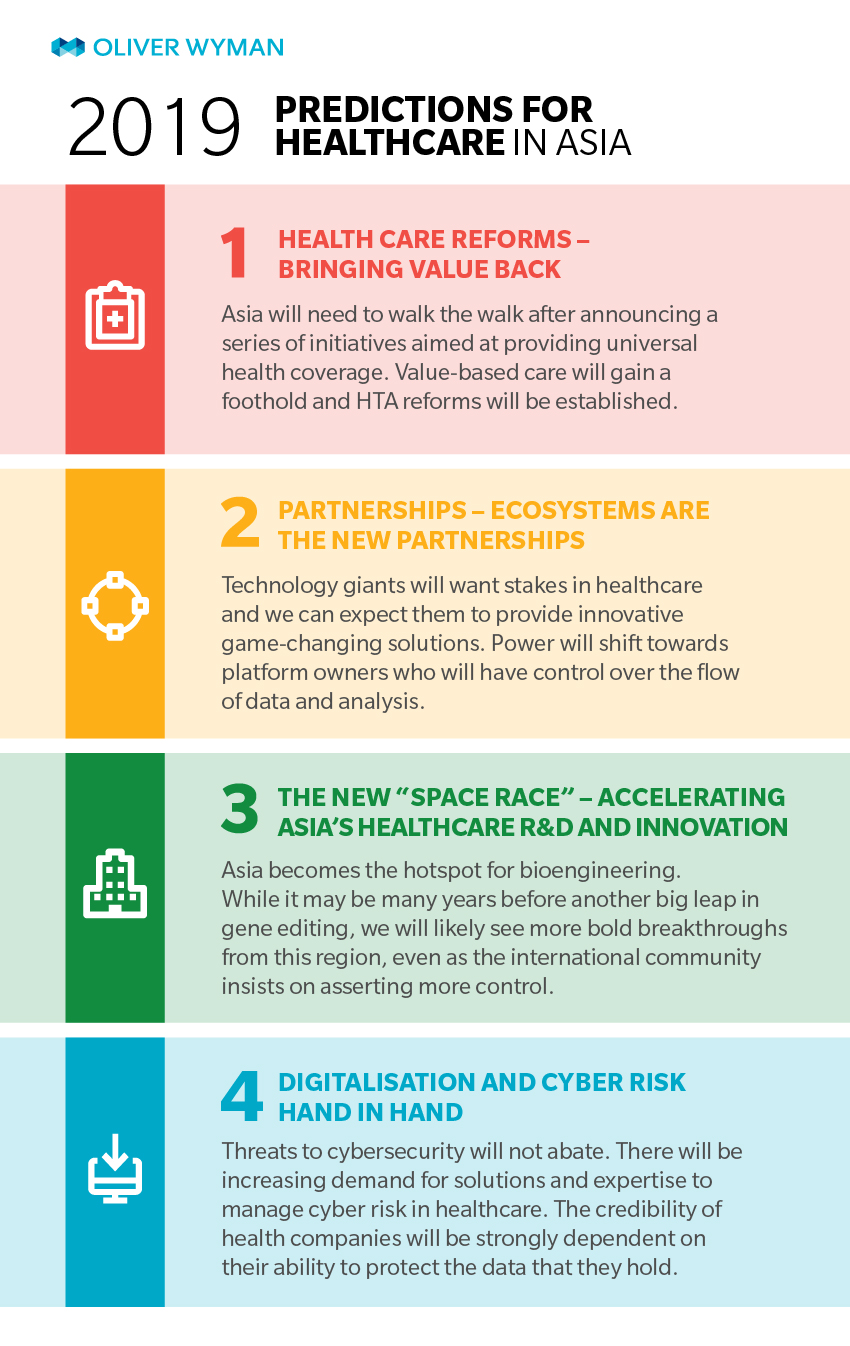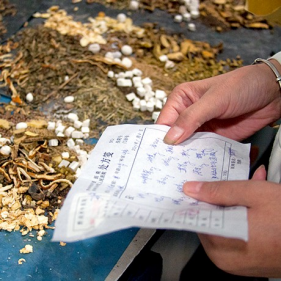A Look Back At 2018 Predictions
Asian healthcare made notable strides in many areas in 2018, as expected, but there also remains much work to be done. Universal healthcare and digitalization hit a few regulatory hurdles and setbacks. While regional M&A deals and partnerships continued, these remain dwarfed by massive deals in the United States, such as those between CVS and Aetna and the JPMorgan-Berkshire Hathaway Amazon partnership. These signaled a new era of industry integration that has not yet reached Asia.
Nevertheless, as with New Year Resolutions we can look back at our Healthcare Predictions for Asia 2018 and see how we fared:
Universal Healthcare: From Fairy Tale to Reality?
Universal healthcare made significant advances in some Asian countries. The Philippines’ Senate passed a Universal Health Care Bill. India launched Ayushman Bharat, a major step forward. Singapore increased coverage of Medishield Life at a more sustainable cost, and also introduced CareShield Life, one of the region’s first long-term care plans. However, Indonesia’s BPJS national scheme faced continued deficits, proving an effective universal healthcare system for any country is a long journey indeed.
New Partnerships – Connecting the Dots
Incumbents such as payers and pharmaceutical companies continued to seek to defend their market positions through digital partnerships to enter new parts of the value chain. Notable examples included Ping An Good Doctor and Grab, and Prudential's AI-backed ecosystem in Singapore, with partners including Prenetics, DocDoc, MyFiziq and WellteQ (and eventually Babylon Health, a startup darling from the UK). It is still too early, however, to say broadly what impact these innovative partnerships will bring. Governments have also spearheaded private partnerships: for instance, last year, Singapore’s Health Promotion Board called for private collaboration on projects such as the National Healthy Population Project. However, such government-initiated partnerships are still the exception rather than the rule.
M&A Hotspots – Bigger and Better
M&A activity rose in 2018, with 154 Asian healthcare deals valued at over $50 million each, up from 141 deals in 2017. Notable hotspots were India, Singapore, Indonesia, and Malaysia. IHH Healthcare made big moves; private equity renewed its interest in local healthcare activity; and there were many cross-border deals. However, investors will rightfully remain wary in the near-term – despite the hype, the response to Ping An Good Doctor’s IPO last April was tepid and shares have hovered far below the first day peak throughout the year.
Digital Acceleration – Finally
Healthcare is increasingly going digital, with advances in both public and private sectors.
- The Philippines Food and Drug Administration (FDA) selected mClinica to create the region's first national electronic pharmacy information system.
- “AI doctors” are gaining traction, with WeDoctor and Ping An Good Doctor leading the trend in China. Prudential Asia announced a new partnership with Babylon to offer digital health management solutions.
- Big digital technology companies, such as Tencent and Alibaba, announced new healthcare ventures.
- Investment in digital health totaled $6.3 billion in Asia in 2018, with the greatest number of new announcements and investments coming from China and India.
Of the four themes above, we had expected a steady stream of partnerships and digitalization activities, but government reforms and M&A had a quantifiable uptick in activity from previous years. Hopefully, this increased activity also means we will see more regulatory flexibility, so that governments and private consolidation become enablers rather than barriers to new applications and innovations in health in 2019.
We believe these themes will continue to have ongoing relevance for the foreseeable future. Here’s how we see Asian healthcare developing in 2019.
Predictions for 2019
1. Reforms Will Shift Value in Healthcare
Asia had some big successes in progressing universal healthcare last year – such as in India, the Philippines, Thailand, and Singapore – and 2019 will test how robust these initiatives are. Following national elections, we can expect steps towards some painful but necessary guidelines and legislation, which will better define the areas where the public sector is deficient and private enterprise can provide support.
As the structural reforms of 2018 begin to take effect, a new wave of opportunities will come in implementing and strengthening value-based care in existing systems. Payers – both governments and private insurers – have been investing steadily to prepare for long-term change management in reimbursements. The Philippines has signalled a move towards an evidence-based diagnosis-related group (DRG) payment scheme across a broader range of services for its PhilHealth social insurance programme. Insurers such as AIA have continued to implement pre-authorisation and other plan features that place a heavier weight on outcomes to determine eligibility for medical care coverage. A new wave of reforms in health technology assessment in Japan and China will emphasize outcome-driven reimbursements and value-added services which will impact the profit margins of providers and pharmaceutical companies.
2. Ecosystem Partnerships Will Go Beyond the Healthcare Industry
While not a novel strategy, ecosystem partnerships will be a major theme in 2019 as the consumerization shift reshapes healthcare as it has done many other industries. Many pharmaceutical companies and payers have ventured out from their traditional B2B focus, spending on innovation centres and funds in the hopes of finding and owning the next healthcare unicorn. However, other players also see an opportunity to take a share of the region’s growing healthcare spending, and the industry is attracting the likes of regional telcos, banks, and the new kings of Asian tech such as Alibaba, Tencent, and Grab. Such new stakeholders are piloting new technology, financing products, marketplaces, and tie-ups with innovators and incumbents to access new segments of the population. At the same time, we will see trend in more personalized offerings – in terms of health, wealth, and access to information – which has long been a forte of the tech and consumer players, but now an increasingly important capability for healthcare incumbents as well.
While these many new parties want a piece of the pie, the eventual winner will be the one that controls the serving dish – in other words the owner of a platform connecting players to customers that governs when and where cash and data flow. Such a platform could be the key to generating insights with real commercial potential and impact for healthcare players. While insurers are well positioned to act first, they don’t currently have access to a broad-enough segment of the mass market and suffer from a relatively low level of consumer trust. However, regional telcos and banks don’t necessarily fare better in this regard. This opens the door for regional disruptors such as Grab, CXA, or Ping An to expand outside their home markets and offer broadly accessible products to underpenetrated markets in Asia.
3. The New Space Race: Asian R&D and Innovation Accelerate
The centre of innovation and engineering for medtech and devices is beginning to shift towards Asia. Last year, China developed its first drug-releasing heart stent, and many companies are developing research partnerships with local universities, medtech firms, and hospitals. Singapore and China have made massive investments to attract biotechnology to their shores and creating new global hubs, such as China’s Zhangjiang Pharma Valley.
At the same time, the “CRISPR” babies controversy that originated in a Chinese university at the end of 2018 has also opened a Pandora’s box over the ethics, consent, and morality of gene editing. It also showed that some parts of Asia might be prepared to redefine and bend some international norms. If fields like gene editing will be the space race of this generation, we can likely expect key advances to come from the power players in this region, given the large number of research projects combined with looser regulations than in the West.
4. Digitalisation and Cyber Risk Hand in Hand
Along with the automation and integration that we predicted in 2018 comes a need to invest in cybersecurity. 2018 was a year of leaks and breaches: In the 12 months to October 2018, 27 percent of healthcare organizations reported a cyberattack1. Even Singapore’s much-lauded public healthcare system experienced a high-profile data breach affecting 1.5 million patients, as did Hong Kong. More attacks are likely to occur, and it takes almost five times2 as long to detect an intrusion for companies in the Asia-Pacific region compared to global counterparts.
Governments are increasingly beginning to understand the risks and how to mitigate them. Singapore, for instance, has responded swiftly and strengthened its healthcare cybersecurity introducing several new measures. That will likely trigger a growing wave of hires for cyber security roles and technology investment in the region. While larger insurers, hospitals, and other stakeholders have gradually built up their cyber resilience, smaller players will also need to make investments in order to retain customers. Public tenders for digital health projects will have lengthy sections assessing risk, given the high-profile nature of these attacks.
Conclusion
Even with the global geopolitical climate in its most tenuous and unstable state in recent memory, the pace of healthcare change will continue steadily: It must, because Asia’s populations are growing older and sicker. In partnership with BRINK and Marsh & McLennan Insights we will shine a spotlight on the major themes in Asian healthcare throughout 2019.
1 Source: Marsh-Microsoft Global Cyber Risk Perception Survey 2017
2 Source: FireEye and Marsh & McLennan Companies (2018). Cyber Evolution: En Route to Strengthening Resilience in Asia-Pacific












